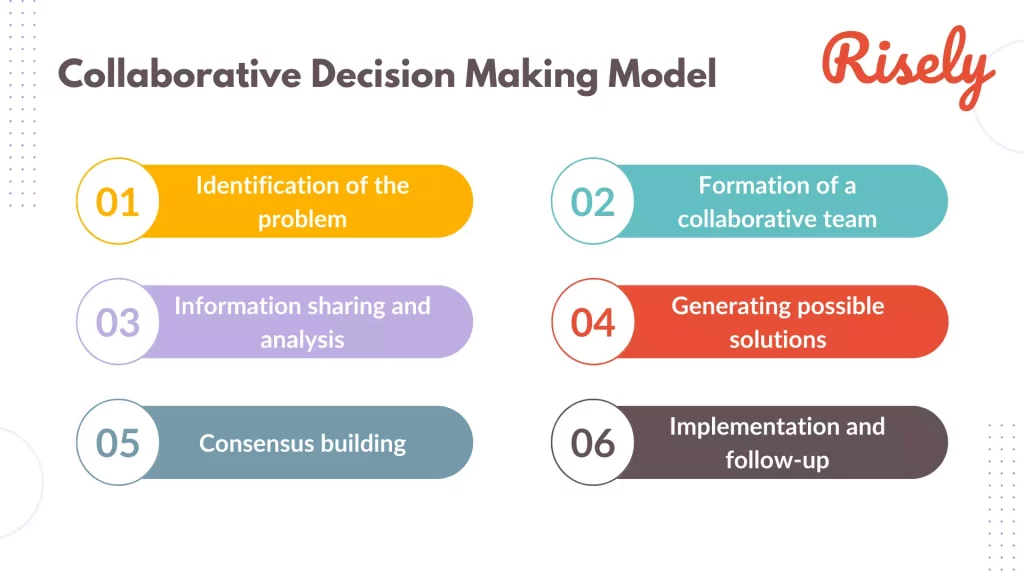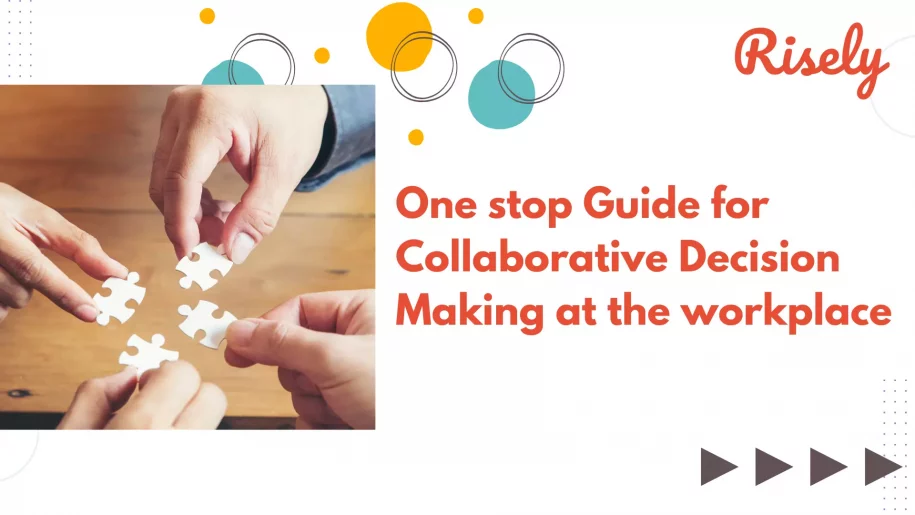One stop Guide for Collaborative Decision Making at the workplace
In today’s fast-paced and complex business environment, making effective decisions is crucial for the success of any organization. As a manager, you are often faced with difficult choices that can significantly impact your team and the company as a whole. One approach to decision making that has gained popularity in recent years is collaborative decision making. By involving multiple stakeholders in the decision-making process, collaborative decision making can lead to better decisions, increased acceptance of decisions, and greater transparency. In this blog, we will explore the advantages and disadvantages of collaborative decision making and provide some techniques managers can use to facilitate group decision making. We will also provide real-world examples to illustrate how collaborative decision making can be applied in different contexts. Whether new to collaborative decision making or looking to improve your existing process, this blog will provide valuable insights and practical tips to help you make better decisions and build stronger relationships with your team. Let’s explore!What is Collaborative Decision Making?
Collaborative decision-making involves engaging stakeholders in a well-informed and inclusive consultation to arrive at the best possible solution to a problem. It involves multiple individuals coming together to agree on a course of action and consider alternative options before making a final decision. In this case, the group has an equal say in the outcome. This practice facilitates open dialogue, more time to consider various options, and fewer biases. The decision-making process could be facilitated by having an impartial facilitator present and facilitating the participants’ discussion on various issues of concern. This often takes longer than independent decisions because participants have time to discuss the pros and cons of each option, resulting in a better solution for the group. The cooperation element of collaborative decision-making requires all stakeholders to be involved and committed to finding solutions. In addition, it requires stakeholders with different expertise, backgrounds, and perspectives to work toward a common goal (i.e., greater diversity).Collaborative Decision Making Model
Collaborative decision making is a model that emphasizes multiple stakeholders’ participation in the decision-making process. It is often used when the decision significantly impacts various people or groups and where a single decision-maker may not have all the information or perspective necessary to make an informed decision.
- Identification of the problem: The first step in the collaborative decision-making process is to identify the problem or issue that needs to be addressed. This may involve gathering information from various sources, such as stakeholders, data, or experts.
- Formation of a collaborative team: A collaborative team is formed once the problem has been identified. This team includes stakeholders from all relevant groups, such as customers, employees, and management.
- Information sharing and analysis: The team works together to share information and analyze the problem from multiple perspectives. This may involve brainstorming, data analysis, or other information-gathering and synthesis methods.
- Generating possible solutions: Based on the information shared and analyzed, the team creates possible solutions to the problem. Each solution is evaluated based on its potential benefits, costs, and feasibility.
- Consensus building: Once the possible solutions have been evaluated, the team builds consensus around the best solution. This may involve further discussion, compromise, or negotiation.
- Implementation and follow-up: Finally, the team implements the agreed-upon solution and monitors its progress. This allows the team to adjust and ensure the solution effectively addresses the original problem.
Group Decision Making Advantages
Collaborative decision making has several advantages over other forms of decision making. Here are some of the main advantages:- Improved decision quality: By involving multiple stakeholders in the decision-making process, collaborative decision making can result in better decisions. This is because a wider range of perspectives and expertise are taken into account, leading to more creative and informed solutions.
- Increased acceptance of decisions: Collaborative decision making can increase the acceptance of decisions because all stakeholders have had an opportunity to provide input and have been involved in the decision-making process. This can lead to greater buy-in and commitment to the decision.
- Greater transparency: Collaborative decision making can be more transparent than other forms of decision making because all stakeholders have been involved in the process. This can reduce the likelihood of rumors, misunderstandings, or suspicion about the decision.
- Increased trust: Collaborative decision making can build trust among stakeholders because they have had an opportunity to work together and see each other’s perspectives. This can lead to better working relationships and improved communication in the future.
- Greater sense of ownership: Collaborative decision making can create a greater sense of ownership among stakeholders because they have had a direct role in the decision-making process. This can lead to greater commitment to the decision and greater willingness to implement it.
Other Interesting Reads
Group Decision Making Disadvantages
The advantages of collaborative decision making are undeniable. Due to its ability to reduce the time spent debating and Collaborative decision making has many advantages, but it also has some potential disadvantages that should be considered. Here are some of the main disadvantages:- Time-consuming: Collaborative decision making can be time-consuming because it involves bringing together multiple stakeholders and working through a process of consensus-building. This can be a disadvantage if there are time constraints on the decision-making process.
- Difficult to manage: Collaborative decision making can be difficult to manage because it involves managing the input and opinions of multiple stakeholders. This can be a disadvantage if the manager lacks the necessary facilitation or leadership skills to manage the process effectively.
- Potential for groupthink: Collaborative decision making can lead to groupthink, which is a phenomenon where a group of people prioritizes conformity and agreement over critical thinking and analysis. This can lead to suboptimal decisions that are not fully evaluated or challenged.
- Resistance to change: Collaborative decision making can result in a resistance to change because it requires buy-in and consensus from multiple stakeholders. This can be a disadvantage if some stakeholders are resistant to change or have competing interests.
- Conflicts and disagreements: Collaborative decision making can lead to conflicts and disagreements among stakeholders, which can slow down the decision-making process or lead to an impasse. This can be a disadvantage if the process is not managed effectively or if stakeholders are unable to work through disagreements.
Techniques for Group Decision Making
There are several techniques that managers can make use of to involve different team members in the decision making process. Here are some of these techniques of group decision making:- Brainstorming: Brainstorming is a technique that involves generating many ideas within a group in a short amount of time. This technique can be used to explore different solutions to a problem and can encourage creative thinking.
- Delphi Technique: The Delphi technique involves a series of questionnaires to collect and synthesize expert opinions. This technique can be used when dealing with complex or highly technical decisions and is helpful when experts are geographically dispersed.
- Consensus decision-making: Consensus decision-making is a technique that requires all members of the group to agree on a particular decision. This approach encourages group members to find a solution that works for everyone and can be helpful when dealing with highly sensitive or controversial issues.
- Nominal Group Technique (NGT): The nominal group technique is a structured method for group decision-making that involves generating, evaluating, and then prioritizing ideas. This technique ensures that all group members have an equal say in decision-making, leading to a more balanced and thoughtful decision.
- Majority vote: A majority vote is a simple and effective technique where the decision is based on the majority opinion of the group. This technique can be helpful when a quick decision is needed, and there is little time for discussion.
- Multi-voting: Multi-voting is a technique where each group member is given a set number of votes to allocate to different options. This approach can help identify the most popular options and be useful when there are many options to consider.
- Decision trees: Decision trees are a visual way of mapping out different decisions and their potential outcomes. This technique can be helpful when dealing with complex decisions and help groups evaluate different options and their consequences.
- Cost-benefit analysis: Cost-benefit analysis is a technique that involves evaluating the costs and benefits of other options to determine the most cost-effective solution. This technique can be helpful when dealing with decisions that have financial implications.
Collaborative Decision Making Examples
Collaborative decision making involves the active participation of multiple stakeholders in the decision-making process to achieve consensus and develop a solution acceptable to all parties involved. Here are 5 examples of a manager making use of collaborative decision making:- Involving team members in setting team goals: The manager can use collaborative decision making by engaging the team members in setting team goals. This ensures that everyone has a say in what they want to achieve and feels a sense of ownership.
- Evaluating new products and services: When a company introduces a new product or service, the manager can use collaborative decision making to involve various stakeholders, such as the marketing, sales, and research teams. This helps ensure that all aspects of the new product or service are considered and all stakeholders’ concerns are addressed.
- Choosing a vendor or supplier: When selecting a vendor or supplier for a particular project, the manager can use collaborative decision making to involve various stakeholders, such as the procurement team, finance team, and project team. This helps ensure that all perspectives are taken into account and the best decision is made for the organization.
- Hiring decisions: When hiring new employees, the manager can use collaborative decision making to involve the team members working with the new hire. This helps ensure that everyone is on the same page about what skills and qualities the new hire should have, and it also helps build team cohesion.
- Resource allocation: When deciding how to allocate resources, such as time and money, the manager can use collaborative decision making to involve various stakeholders. This helps ensure that all priorities are considered and the best decision is made for the organization as a whole.
Conclusion
Collaborative decision-making is a process that involves group decision-making, in which members of the group exchange ideas, thoughts, and feedback regarding issues of concern. The group members make decisions as a team, and each member has an equal say in decision-making. It can help groups reach collective decision-making objectives more quickly and efficiently than individual decision-making processes. You can use several techniques to make collaborative decision-making effective at your workplace. For example, you can facilitate a team discussion to allow team members to express their concerns and brainstorm solutions. You could also organize team-building activities that will enable team members to interact with one another and work toward shared goals. Lastly, collaborative decision-making is best supported by establishing clear team goals and objectives and tracking team progress using performance measures. With these input and output points in mind, you can use collaborative decision-making methods in your workplace to succeed.Identify the hits and misses of your decisions today!
Take the free decision-making assessment for managers to find ways to improve
FAQs
What are the six steps of collaborative decision making?
1. Identifying the decision to be made.
2. Gathering relevant information.
3. Exploring options and alternatives.
4. Considering individual preferences and values.
5. Making the decision together.
6. Evaluating the decision’s outcomes and adjusting if needed.
2. Gathering relevant information.
3. Exploring options and alternatives.
4. Considering individual preferences and values.
5. Making the decision together.
6. Evaluating the decision’s outcomes and adjusting if needed.
How are decisions made in a collaborative environment?
In a collaborative environment, all participants make decisions through open communication, active listening, and consensus-building. The process involves pooling ideas, considering different perspectives, and working towards mutually agreed-upon solutions.
Other Related Blogs
10 Signs You’re Struggling with Analysis Paralysis at Work
10 Signs You’re Struggling with Analysis Paralysis at Work The smart fox declares, “I have a hundred ways to escape when trouble approaches. You have only one.” As the dogs…
Evidence Based Decision Making: 4 Proven Hacks For Managers
Evidence Based Decision Making: 4 Proven Hacks For Managers In this blog, we will explore the concept of evidence-based decision-making and provide seven proven hacks for managers to implement evidence-based…
6 Best Books On Decision Making For Managers
6 Best Books On Decision Making For Managers Effective decision-making is crucial for managers to navigate the complexities of their roles. You are responsible for making important choices that can…
Best Decision Coaches To Guide You Toward Great Choices
Best Decision Coaches To Guide You Toward Great Choices Effective decision-making is more crucial than ever in today’s rapidly evolving business landscape. Entrepreneurs, leaders, and professionals alike are constantly faced…


